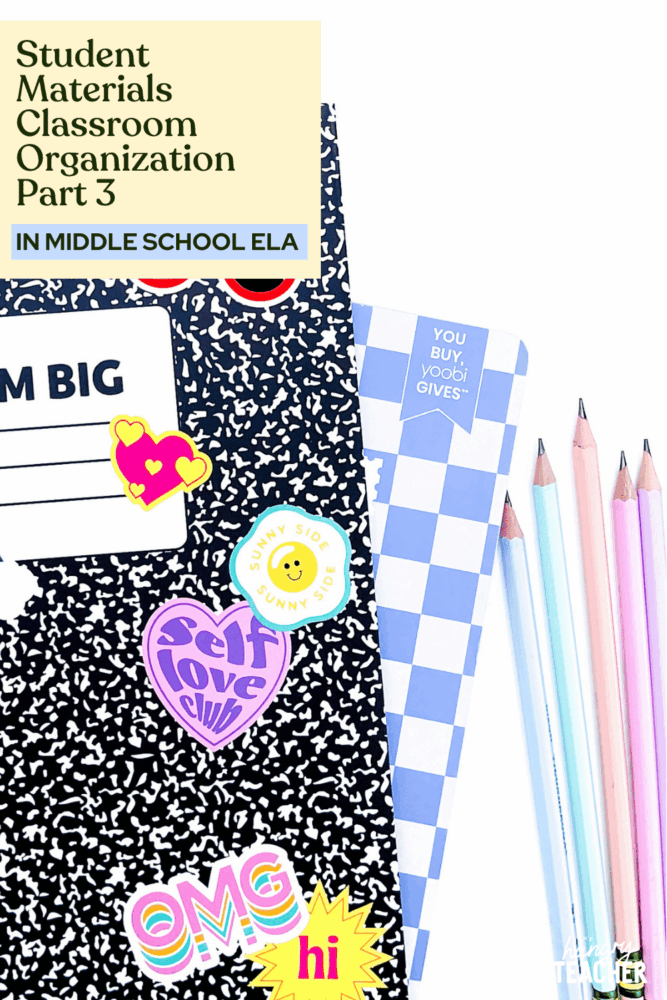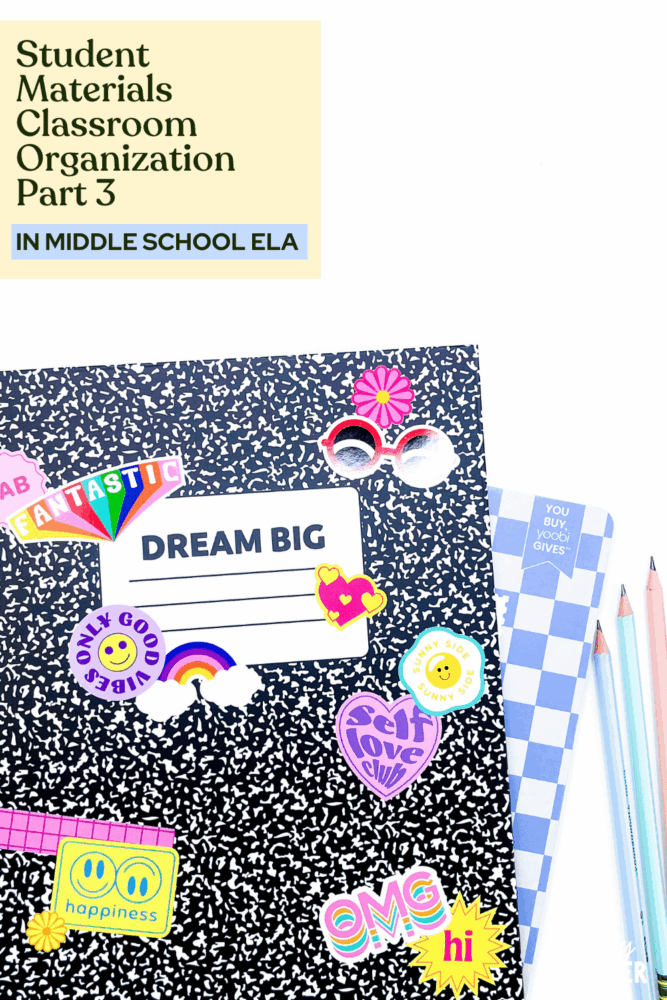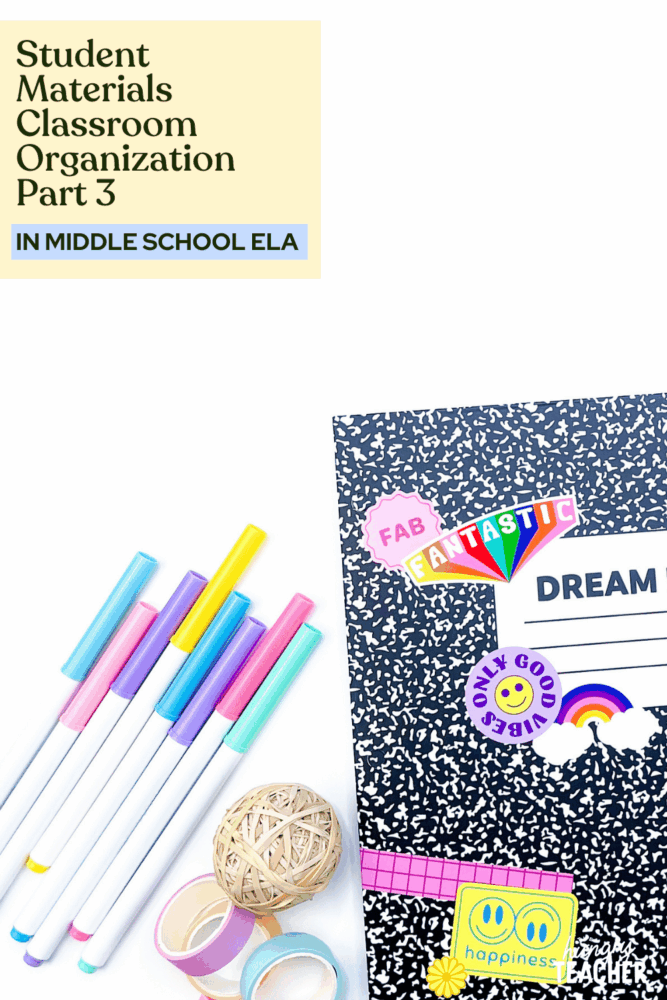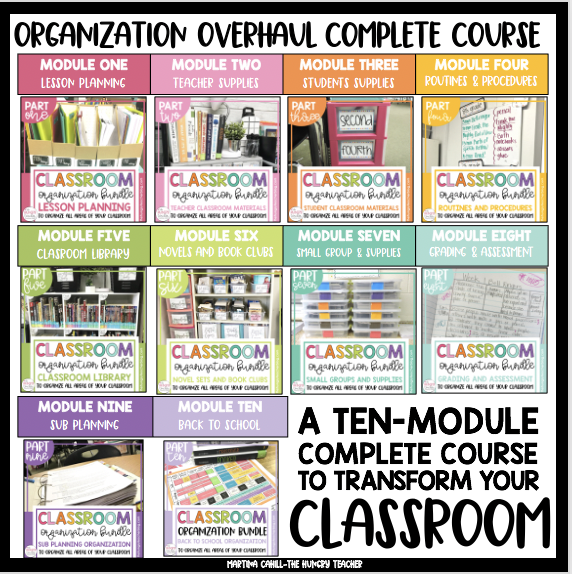hey friend!
I'm Martina.
I provide practical, time-saving strategies that actually work—so you can engage your students, teach effectively, and reclaim your time from the exhausting planning-grading cycle.
Browse Our ELA Resources
Student Materials Classroom Organization | Part 3
This middle school English teacher grading strategies for upper elementary and middle school grading and assessment blog post is part of a classroom organization series. This is part eight of ten blog posts all about how I organize different areas of my classroom. Click on any of the links to be taken to each of the posts in the series:
- One: Lesson Planning and Lesson Materials Organization
- Two: Teacher Materials Organization
- Three: Student Materials Organization
- Four: Classroom Routines and Novels Organization
- Five: Classroom Library Organization
- Six: Book Clubs, Novel Sets, and Literature Circles
- Seven: Small Group Organization
- Eight: Grading and Assessment
- Nine: Long-Term and Short-Term Sub Planning
- Ten: Back to School Organization
CLICK HERE to get the Organization Overhaul Complete Classroom Course plus bonus resources for each module.
CLICK HERE to get the complete printable organization E-Book.

Get the Organization Overhaul Complete Classroom Course
BOOKS AND MOVIES ORGANIZATION
The only difference I have for student organization with notebooks is for my sixth grade classes. They are my elective classes, the last hour of every day (Books and Movies). This is an A/B schedule, meaning I see one class Monday, the other Tuesday, back to class one on Wednesday, and so on).
I also didn’t want to buy a whole other set of bins for the ends of table groups (maybe next year) but also didn’t want it to be a hot mess every time they needed their supplies.
Sixth grade notebooks are kind of similar to seventh and eighth because they do have tabs and sections.
The difference in organization is how they are stored. 6A is in the blue container and 6B is in the gray container.
Then took colored labels (more on these later) and put them on the sides, so that students can come into the room find their general color, grab their notebook and their novel quickly. That way we aren’t all waiting for one person to try and find their notebook.student organization
Again, like many previous systems, as I was able to purchase more or move around more organizational shelves or containers, I adjusted to make them work better. I finally had an extra bookshelf for my 6th graders, so all their materials could go on these shelves.
My 6A class notebooks and current book/movie novel (The Maze Runner) is on the left side and my 6B class notebooks and book/movie novel (The Hunger Games) are on the right hand side.
SHARED SUPPLIES STUDENT MATERIALS
I have always had some type of community supplies in my classroom.
Even in middle school, they have caddies for all our interactive notebooking.
I also invested in adult scissors for all tables because #icanteven handle waiting for the kids using the small scissors.
The metal caddies are from the garden section of Target!
Their caddies always have crayons, markers, colored pencils, glue and adult scissors. I used to have just enough, but now I am adamant that there is enough for everyone to have their own glue and scissors.
I’m all for sharing, but with 55 minutes class periods, I can’t waste any time anymore.
Originally I didn’t have “table numbers” on the caddies in my middle school classroom, because I didn’t think they were necessary. Eventually I needed them to dismiss tables for our silent reading time, so then I added them.
SHARED SUPPLIES IN 5TH AND 6TH GRADE
These were the table caddies and the organization system I used in fifth and sixth. We had to have cups inside the caddies, because otherwise it was a mess. I just used cheap plastic ones I had leftover from a classroom party.
No picture of this, but I saw a second grade teacher put pictures of how the bins should look on the bins, and eventually I did that too (even in 6th grade!) It seriously helped so much. As I was typing this, I was actually thinking I should do it for my seventh and eighth graders as well. I really don’t think it can ever hurt.
Lastly, and I don’t have a picture again, but the best thing I ever did was get small little buckets to serve as trash cans at each table.
Extra materials organization
Now I teach middle school, and before this I never had desks (thank God!). I am not a fan, but they actually don’t bother me in middle school because my middle schoolers don’t need or want to put their stuff in them. They became a perfect storage space for my textbooks and anthologies.
If I didn’t have the desks, I would have had to fit all of these books on bookshelves and I don’t think that would have even been possible with my space. With six books in each desk, I still have extras on my shelves.
Even if I didn’t have desks, and also didn’t have or want to use bookshelves, then I honestly probably would have purchased more of those 3-drawer plastic bins, that I keep at the end of the desks to hold notebooks, to hold all of these books.
Miscellaneous Student Materials
These are just a couple miscellaneous sections of my classroom, but there are some super helpful tips.
One of the best things I ever did was make a “lost and found” box in my classroom. This is amazing when you have more than one class in your classroom. That way when students leave small stuff like pens, water bottles, lunchboxes, or even notebooks with no names, I just put them in the small lost and found box.
Students usually come back next class period, a friend recognizes who it belongs to, or they see it the next day. It rarely stays full for more than a day.
That way I don’t have to “hold on” to it and/or put it in the huge lost and fund that builds up all year.
This worked way better because it’s much sturdier and things don’t get hidden on the tiny shelf pictured above. Everything they might need is here: stapler, tape, hole puncher, pencils, pencil sharpener, and notebook paper.
Here is the same picture from earlier when I was showing how I stored my sixth graders’ materials.
This is also now my students’ station for supplies they need. The previous desk was a cheap piece that was honestly barely standing.
It worked when I didn’t have a budget for something else, but eventually was able to make this area for my students.
Student computer station organization
We honestly only use these computer as extras to check out books and for testing, but it’s nice always having a back up.
Nothing fancy here, but I do like how I was given these two desks that have side baskets on them. Now I can just put all the cords into these baskets. If I didn’t have these, I would probably just turn two regular desks backwards and stick the cords in the desks so I didn’t have to look at ALL the cords.
I also keep ALL of my headphones in those plastic blue and green bins for students to grab for computer or for our iPods.
Like many things, I have been working to make things more aesthetically pleasing and less cluttered over the years.
We don’t need all the extra headphones, and I’ve since donated them to elementary.
I also made the first bulletin board before I knew where I would have to put my computers. We never could use it, so when I adjusted I made a new bulletin board that I could actually display extra chart papers.
English student notebook organization
This isn’t technically student materials, but it is definitely something that I want to address.
These are my notebooks, that match up with my students’ notebooks. I have five classes and each class has two notebooks. I learned the hard way to have a notebook for every class (and notebook), otherwise you have already done the examples with one class, and the other class doesn’t work with you (some just copy, some can’t really see, and I tend to move faster because I’m already “done”).
Also, sometimes classes get off, and then you’re behind and/or ahead of one class, and I don’t know about you, but I forget which class is which some days. These notebooks are under the desk where I keep my document camera (because that’s where I show my examples).
Two binders hold the units I create for any novels I teach/use.
The striped one is for sixth grade Books and Movies and the “blue leaves” one has my seventh and eighth grade reading units.
Basically, it has my unit lesson plans, vocab, questions, writing prompts, etc.
The watercolor looking one is my “Workshop Notebook,” and this holds the pages for “Status of the Class,” which is my way of checking on students’ reading daily and weekly.
LABELING STUDENT NOTEBOOKS
This might seem crazy… but I HAD to do it. If you read last weeks’ unit, you know that I have since evolved and write right on the labels. Previously the notebooks, were lower to the ground so it was different.
On the previous page, you saw that the notebooks had colored tape on them. That was so I could differentiate which was which, without having to check the front of each one every single class. The problem is, I don’t have them memorized yet, so then I WAS looking at the covers every single class trying to find the right one….
So I just put the same colored labels at eye level, labeled them, and stuck them right on this desk. Now I just look for “1st INB,” see it’s the dark pink, and then grab it. It’s cut down on the searching time for me. Otherwise, it can be super time consuming if you look at ten different notebooks every class.
ORGANIZING STUDENT NOTEBOOK SECTIONS
We created our notebook tabs and organization at the beginning of the year. It took us about two days to make them because we numbered every single page, and then went a specific number of pages, for each section, but it is SO WORTH it the rest of the year. I will break these down for you on the next few pages.
These editable notebook tabs are available as an exclusive freebie for subscribers for you to utilize for student notebooks. These are an exclusive freebie for subscribers and are only otherwise available for purchase. Click here to get these sent straight to your inbox.
INTERACTIVE NOTEBOOK SECTIONS
Going into a middle school language arts setting isn’t completely foreign to me. Years ago, I had to leave my job, apply for a new job, find a house, and move all our stuff across the state in a matter of weeks. I applied for a job that was advertised as sixth grade self-contained. Long story short, (I have a lot of these) after I was hired I was told I was only teaching ELA. We only had two classes of sixth, but I quickly had to learn a whole new type of organization that I wasn’t used to.
At the end of first semester I was SO over their notebooks. I knew I was partially to blame. That night, I went to the store and bought 50 notebooks. Then I glued in labels after counting the exact number of pages I wanted them to have.
Here is a break down of our notebooks, how we count the pages out, and how we organized them.
I learned some really important things even after I got my sixth graders SUPER organized.

NOTEBOOKS FOR EVERY CLASS
I initially only made one notebook for myself, but that didn’t work because I would do the lesson with 6A and then 6B would just copy my examples and we weren’t learning together. Also, sometimes I would get ahead and/or behind in a class and… just don’t even get me started.
This year I have five ELA classes, but four of these classes have two notebooks each. I do have ten notebooks, but trust me when I say to have a notebook for every class.
COUNTING PAGES FOR EACH SECTION
Know EXACTLY how many pages you want for each section.
NO PROMISES that ALL of your students will use the number of allotted pages you have designated (because some of them are in a continual hormonal brain fog) but this helped about 95% of my students (and me!) stay on track.
I am such a freak about our notebooks and student organization, but I can say it was SO worth it to have all this determined ahead of time. I made all of my sixth graders’ notebooks, but this year, I spent an entire class period making them with my seventh and eighth graders. We went REALLY slow, made them number every single page, and then modeled like crazy. They weren’t allowed to touch the glue until I said so. It worked though, and most notebooks are perfect.
NOTEBOOK 1: 7TH/8TH ELA NOTEBOOK
They know that this notebook is only for writing in. We NEVER glue anything into this notebook. Trust me, when I say you need to make this very clear to your “big kids,” and some still just won’t get it.
- Two pages (front and back) for the table of contents. This gives us four whole pages to write our contents.
- Thirty-six pages (front and back) for bell ringers. This gives us one page (front and back) for each week of bell ringers (more on bell ringers in the next unit).
- Reading Response is the rest of the pages in the notebook. This is where they write all their responses to our reading units.
NOTEBOOK 2: 7TH/8TH INTERACTIVE NB
I found it was SUPER important to have a separate interactive notebook for student organization. Students then knew that we ONLY glued stuff into our Interactive notebook. Before this rule, students were gluing all over the place, on top of writing, and/or we would run out of room in some notebooks:
- 2 pages (front and back) for table of contents again
- 35 pages (front and back) for interactive reading lesson
- 16 pages (front and back) for interactive vocabulary lessons
- 16 pages (front and back) for interactive writing lessons
- 35 pages (front and back) for interactive grammar lessons
NOTEBOOK 3: 6TH GRADE BOOKS AND MOVIES
I’m teaching at a different school this year and one of the sixth grade electives is “Books and Movies.” FREAKING OUT (in a good way) about this.
Sixth grade might be my favorite now and I love books that have been turned into movies. But 6th grade student organization is something to be desired ha!
I plan to do Holes, The Hunger Games, and Harry Potter (obviously). I plan to use my reading units, so this is the breakdown for their notebooks.
- 2 pages (front and back) for the table of contents.
- 18 pages (front and back) for bell ringers. This gives us one page (front and back) for each week of bell ringers. I only have each 6th grade class for one semester.
- 10 pages (front and back) for vocabulary. We will do some vocabulary during our units.
- 15 pages (front and back) for Reading. We will use this for mini-lessons and maybe some interactive notebook lessons.
- Reading Responses are the rest of the pages in the notebook. This is where they write all their responses to our reading units.
This was based on my pacing guide and how many pages I thought I would need for each section.

ELA notebook tabs organization
Again, I plan to change things up once again this year. The numbering of the notebooks worked for about 90% of my students. The only issues I seemed to come across is that some students purchase composition notebooks that have less pages than what I have paced for.
I like the idea of us creating a new tab or section for each unit we start. Since them, I began creating some reference page notebooks tabs. Click here or on the picture to get any of these notebook tabs.
This middle school English teacher grading strategies for upper elementary and middle school grading and assessment blog post is part of a classroom organization series. This is part eight of ten blog posts all about how I organize different areas of my classroom. Click on any of the links to be taken to each of the posts in the series:
- One: Lesson Planning and Lesson Materials Organization
- Two: Teacher Materials Organization
- Three: Student Materials Organization
- Four: Classroom Routines and Novels Organization
- Five: Classroom Library Organization
- Six: Book Clubs, Novel Sets, and Literature Circles
- Seven: Small Group Organization
- Eight: Grading and Assessment
- Nine: Long-Term and Short-Term Sub Planning
- Ten: Back to School Organization
CLICK HERE to get the Organization Overhaul Complete Classroom Course plus bonus resources for each module.
CLICK HERE to get the complete printable organization E-Book.
Get the Organization Overhaul Complete Classroom Course
Want a sneak peek at teaching The Hungry Teacher way—with support, structure, and strategy?
When you join the waitlist for The Hungry Teacher’s Hub membership, you get three free classroom-ready resources: a theme unit, an expository writing unit, and a grammar unit introducing mentor sentences. Plus, you’ll get immediate access to a selection of exclusives from the Hub, including editable sub plans, pacing guides, and more.
No strings attached. Just resources you can use right now—and a heads-up when the Hub opens.
3 Free Middle School ELA Units—yours to keep!
JOIN THE WAITLIST + A FREE GIFT
Where to next, line leader?
Welcome to The Hungry Teacher! We create resources that are easy to use, practical, and get results. Teach with confidence—and make it home before dinner.
xo, the hungry teacher

